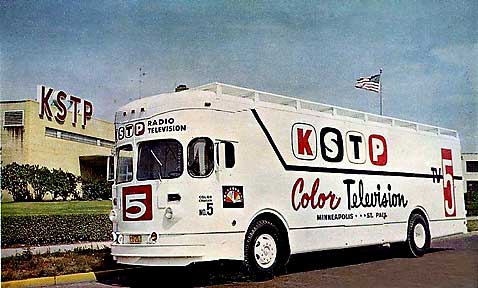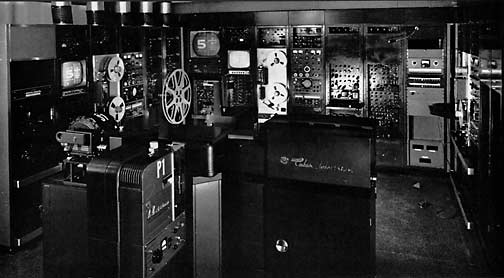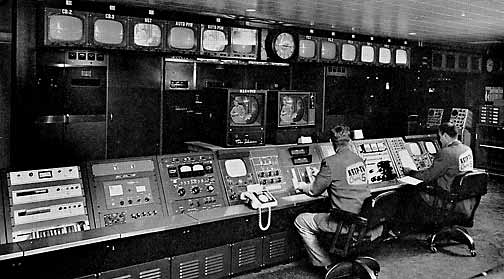|
|
|||
 |
|||
|
The May 1962 "Broadcast News" feature story about KSTP-TV, Minneapolis-St. Paul, continues.... |
|||
|
STUDIOS |
|||
 Pantagraph mounted 5-kw Sky Pan, showing Joe Reznick inserting a color gelatin filter. |
 Stage section of Studio 3. Overhead are motor driven lighting battens. Also rails for flying of scenery and props. |
||
|
A great deal of editing and splicing is done. It's not unusual to run 20 splices in a half hour show. The Christmas color special, for example, included 50 splices. All of these are made with the regular RCA TV Tape splicer but with a KSTP-designed mounting bracket for "sit-down" use. KSTP has proved the efficiency of installing more than one machine, since with two, one can run tape shows back-to-back. They can also insert commercials and other small pieces into programs without having to edit the master tape. It has been found very convenient as well as economical to use separate small reels for individual commercials and announcements rather than edit them in and out of show tapes. (Webmaster note: RCA's rival, Ampex, claimed the rights to the name "Video Tape," hence RCA's use of the name "TV Tape." However RCA used the Ampex 2" quadruplex recording format and the recordings from both manufacturers were compatible). |
|||
|
|
|||
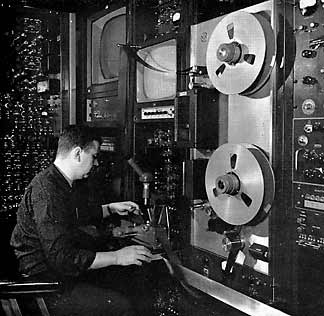 Dick Elliot at the "sit down" splicer position designed by KSTP staff. This features a special mounting bracket that makes splicing easier. (Webmaster's note: before the advent of electronic editing, early videotape was literally spliced, but since the video image is not visible on the strip of tape, a cumbersome process of finding the electronic frame line using a special magnetic fluid and viewing and cutting under a microscope was used. |
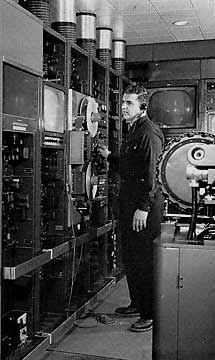 KSTP has three TRT-1B Color TV Tape Recorders. Note exhaust ducts at top. (Webmaster's note...the TRT-1B requires 3 racks: 1 for the tape transport, and 2 additional racks for video and waveform monitors and Recorder tubes and electronics. |
||
|
Two complete film islands are installed at KSTP. One is completely monochrome, while the other can be both color and monochrome. Each is equipped with two 16mm sound-on-fim (S.O.F.) projectors and 2 by 2 slide projectors. |
|||
|
|
|||
 The engineering brain trust of KSTP. Left to right: George Merrill (holding instruction manual), Kess Pool (holding audio amplifier), Dick Elliot (reel of TV Tape), John Reinke (transmitting tube), Hugh Mulhollam (image orthicon tube from TK 41 color camera), Fred Debeaubien (holding catalog), and Director of Engineering Operations Fred Street (extreme right). |
 The KSTP photo-news staff of 33 photographers, writers, editors, and technicians. |
||
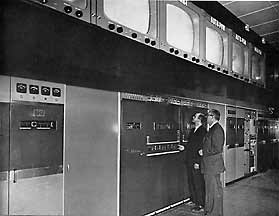 The RCA TT-25CL 25-kw main TV transmitter |
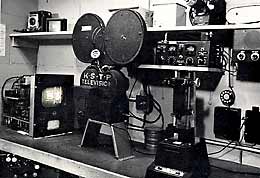 KSTP's kinescope setup, used mostly before the advent of TV Tape Recording. Here is an Auricon Pro fitted with Mitchell 1200 ft. magazine is mounted in front of a TM-6 master monitor. |
||
|
(Webmaster's note: In KSTP's simple kinescope film recording setup, the video monitor being filmed is not underscanned, virtually assuring that vital picture area is being cropped out to avoid seeing the physical edges of the televison screen. This practice was unfortunately quite common in the days before TV Tape, when the only way to preserve a television image was to film it off a TV screen. Kinescope recordings are vastly inferior to TV Tape which revolutionized TV broadcasting. Unfortunately, the "convenience" of re-recording virtually destroyed many now-historic television broadcasts when tapes were "degaussed" and reused. Non-eraseable film kinescopes are the only surviving recordings of many late 1940's-1960's television broadcasts.
Kinescope film recordings improved in the 1960's, but since TV Tape (or Video Tape) was becoming increasingly more popular, knescope film recording was destined to be obsolete. RCA was still innovating improvements in kinescope recording in the early 1960's. See the RCA's TFR-1 Film Recorder introduced at the 1962 National Association of Broadcasters (NAB) convention. |
|||
|
|
|||
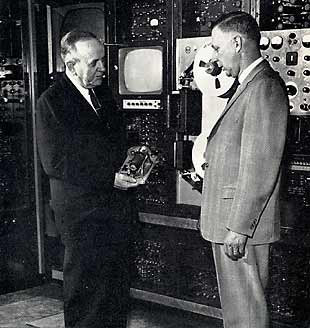 Stan Hubbard - owner of KSTP (left, holding RCA TV Tape Recorder headwheel panel) and Walt Varnum of RCA. Mr. Varnum made a system study of requirements with the KSTP engineering staff that led to the design of the new unique KSTP studio building and master control equipment area. |
KSTP-TV's complete color facilities for live, tape, and film telecasts are among the finest of any station in the nation. In all ways KSTP is endeavoring to fulfill its pledge to serve the public interest. This mark of pioneering spirit is further evident in the switch to color, making KSTP-TV the first station in its Northwest area to offer the finest in television fare to its advertisers and its audiences.to its advertisers and its audiences. | ||
|
|
|||
|
See photos of my antique KSTP-TV color television camera as seen in this article comments? send me an email Visit my Color Television Home Page Learn more about the Color Television Revolution See videos of the original NBC peacocks and ABC and CBS color presentation logos See photos from my boyhood tour of KARD-TV in 1964 See photos of NBC Color City Studios in Burbank, California in 1955 See an RCA 2" Color Television Tape Recorder See TK-40/41 photos along with video clips of TK-41's at work in TV studios See a video montage of an historic demonstration of the RCA compatible color system to the FCC See an excellent 1953 RCA brochure about the development of Color Television Watch the oldest surviving color videotape...the dedication of NBC's Washington, DC color studios in 1958 Watch An Evening With Fred Astaire the oldest surviving color videotape entertainment program (October 1958) Read the fascinating story of the restoration of "An Evening with Fred Astaire" Watch the oldest surviving videotape recording The Edsel Show - October 1957 Want to read more about early color television? Check out these links: Read NPR's coverage of color TV's 50th anniversary visit the late Ed Reitan's website - a very informative site about early color TV visit Bobby Ellerbee's fascinating and compreshensive television history website Eyes Of A Generation visit Chuck Pharis's site to see his collection of antique TV cameras and other early broadcast equipment visit Barry Mishkind's website to see the RCA Television Equipment Archive visit Steve Dichter's CT-100 website to see Steve's vintage color television page |
|||
|
|
|||
|
|
|||
|
|
|||
|
| |||
